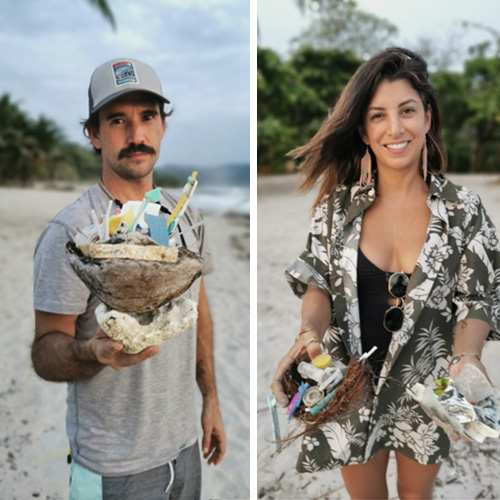
Identifying the challenges that need to be overcome in the journey towards a world free of waste

One of the highlights of the seismic shift in people’s attitudes towards plastic, and sustainability in general, in the last five years has been the response from brands, entrepreneurs and activists re-thinking the plastics industry.
The New Plastics Economy created by the Ellen Macarthur Foundation has taken center stage stimulating innovation, creating a global “race to the top” and helpìng unleash a new level of creativity in the plastics industry.
In just four years since it started its disruption of the packaging industry, the Ellen MacArthur Foundation has galvanized 1,000 organizations behind its goals to eliminate the plastic items we don’t need; encourage innovation so all plastics we do need are designed to be safely reused, recycled, or composted by 2025; and to foster the circulation of everything we use to keep it in the economy and out of the environment.
Reduce, Reuse, Recycle
A new solutions movement has focused on the three Rs – reduce, reuse, recycle – to stem the flow of plastic waste leaking into our environment. Each one has a crucial role to play in improving our management of the material and all of the major stakeholders are being urged to take greater responsibility.
The highly collaborative solutions movement has already reached critical mass forcing nearly all players in the plastics and packaging industry to engage and offer up solutions to the problem of plastic waste, or be labelled as dinosaurs, facing the prospect of extinction.
“The New Plastics Economy is inviting companies to design better, to design circular products so they can design out waste. Right now designs are based on generating waste and not being accountable for it so that’s an invitation for companies to design in a different way to avoid generating waste. Use all these smart people and make them design in another way,” says Mark Minneboo, Regional Director for Latin America at Plastic Oceans International.
“We have to simplify plastic products, we have to change our logistics, we have to change the way we consume, we have to change how we design and we have to change our waste management systems so that no plastics escape in any step of the process from extracting oil to the disposal of a product after its use.”
There are carrots and sticks at play here. The New Plastics Economy has chosen to elevate the conversation by championing innovation and companies going the extra mile whilst governments tired of bearing the cost of cleaning up after everyone, particularly in Europe, have shown that they are prepared to introduce regulation to govern laggards who refuse to come into line with circular economy principles.
Amongst those who have understood the call for change and have taken steps to align themselves with the goals laid out in the proliferation of Plastics Pacts being signed around the world, are the world’s largest producers of consumer goods: Mars, Pepsico, L’Oreal, Nestle, Unilever, Walmart and The Coca-Cola Company. They have all signed up to the New Plastics Economy’s global commitment to make 100% of plastic packaging to be reusable, recyclable, or compostable by 2025. Together the signatories account for 20% of all plastic packaging produced globally.
With these giants signed up to pledges, and activists watching closely to see if they will deliver, a new urgency has been added to find innovative solutions and bring back some older proven technologies – like bottle deposit systems – previously neglected owing to the added costs associated with their operation for brands and plastic producers.
Solutions-Based Movement
With the clock ticking, entrepreneurs, for profit and non-profit enterprises are pulling out all the stops. From beach cleanup organisations to clothing carpet manufacturers and
Up-cycling and toy giant Lego up-cycling plastic bottles to chemical recycling and depolymerization plants, biological alternatives to plastics made with organic materials, the roll out of reuse systems and some impressive design thinking that’s eliminating plastic completely from thousands of products, there are a stream of game-changing initiatives fighting for funding, of which there is no shortage.
Chilean reuse solutions specialist, Algramo, started life in Chile and was catapulted onto the world stage when it won the Ellen MacArthur Foundation’s circular economy prize in 2018. It has noticed an interesting shift in the dynamic since the big brands started pledging to remove single use plastics from their supply chains.
“A couple of years ago, especially prior to having launched a successful pilot with Unilever, we had to call the CPGs and we had to really try and impress them and make amazing PowerPoint presentations showing the feasibility and the benefits of what we could potentially do with them. Now, we literally have most of the major brands coming to us, making PowerPoint presentations, trying to wow us on why we should work with them, so it’s really amazing that we have that level of interest,” says Brian Bauer
None of the solutions are simple or offer a silver bullet to the industry’s biggest challenges. Reuse models, for instance, require value chains to reorganise in order to provide consumers with cost effective, sustainable and – crucially – convenient packaging solutions. Logistics, technology, product design and communications all need to come together to secure market share for this approach. Recycling solutions face the challenge of competing on cost with the production of virgin plastics and biological and other alternatives need to overcome criticism that they will in fact be far more detrimental to the environment than continuing to use plastic.
That said, the incentive that comes with successes like Algramo, creates a path that underlines how creativity can turn what seems to be an extra cost into a financial opportunity that’s too good to ignore.
“It’s not just that this is a burden on your business and that you need to spend loads of money tackling it, there are real opportunities to resonate with people by delivering these options,” says Marie Stafford, global director of Wunderman Thompson Intelligence. Their research Regeneration Uprising pointed to some of the brands winning market share with their creative approach to solving the problem of plastic waste.
Opportunities, Opportunities, Opportunities
Environmental, social and governance (ESG) assets are on track to reach $53 trillion by 2025, according to Bloomberg Intelligence up from $37.8 trillion by year-end.
Companies in the area of packaging that are able to solve three crucial problems: reduce food waste, reduce plastic pollution and reduce the industry’s carbon footprint will be guaranteed interest from these ESG investment funds.
“The gap opening up for solutions and the level of innovation is incredible,” says Stafford. “In terms of materials we’ve seen it accelerate over the past few years and that’s going to continue because whoever understands this, it is like finding the Holy Grail. Discovering something that is less harmful that could actually be beneficial as a material is where we want to move to. It’s a huge opportunity to try and tackle that.”
To date, the consequences of the reputation fallout of being associated with plastic waste has fallen largely on organizations further downstream, with consumer goods producers and retailers feeling the heat most. It’s no surprise that it’s the household names that have responded fastest to the changes being felt at the sharp end of the plastics industry.
Polymer and plastic producers have so far avoided much of the regulatory sticks being wielded by governments tired of cleaning up the industry’s impact. The involvement of these companies, however, will be crucial to reduce the plastic industry’s fossil fuel footprint and it’s here, upstream that the innovation really needs to be taking place, according to a recent report by the Minderoo Foundation.
With a high profile intro by Al Gore, the report The Plastic Waste Makers Index pointed out that a relatively small number of companies (less than 100) were responsible for producing almost 90% of polymers that were used to create the single use plastics finding its way into our environment.
The research estimates that 20 polymer producers accounted for an estimated 55% of waste globally. Identifying the producers of plastic was a simple way to push greater responsibility onto them to participate in finding a solution to the problem of waste.
Two integrated oil and gas companies, US-based ExxonMobil and China-owned Sinopec, rank first and third, respectively, with the largest chemicals company in the world, US-based Dow, at number two. Together, the Minderoo Foundation estimates, these three companies generate around 16% of global single-use plastic waste.
Turning off the Tap Upstream
While further downstream, plastic producers and consumer goods companies are working on ways to reduce, reuse and recycle, the report said chemical giants like ExxonMobil, Dow Chemicals and other state-owned oil companies around the world, were moving too slowly to stem the flow of virgin plastics made with fossil fuel stocks into the supply chain.
“The transition to a circular plastics economy is moving at glacial speed among polymer producers, yet these very same companies are key to solving the single-use plastic waste crisis,” said the report’s author, Dominic Charles, Laurent Kimman and Nakul Saran.
The ownership and funding sources behind these behemoths, who produced 130 million metric tons of single use plastics in 2019, was also a serious challenge to be overcome.
With growing concerns about the impact of regulations on the bottom lines of companies, there are signs that influential investors like BlackRock being able to bring its influence to bear to affect the behavior of management at the largest publicly-traded polymer producers. Tighter regulations on the use of recycled plastics in polymer production in Europe has also resulted in these giant chemical and oil companies taking steps to incorporate more non-virgin plastics into their plastics pipelines.
A Patchwork Response
However, with 32% of the world’s biggest polymer producers state-owned by governments in developing countries, Minderoo’s researchers said it could be difficult to find a unified response to the challenges being faced by the industry.
While European countries have already levied an €800 / tonne plastic waste tax on all plastic that does not contain 30% recycled material, other policy-makers are further behind.
“Urgent work is required to create greater incentives for recycled polymer production,” says Charles. “In India, for example, closed-loop recycling for food-grade single-use plastics is currently prohibited – stalling investment from polymer producers focused on the domestic Indian market such as Reliance Industries, GAIL India and the Indian Oil Corporation.”
The tax in Europe has sparked a spate of investments like Plastic Energy and Ioniqa working with the biggest polymer producers to build chemical and mechanical recycling plants in Europe. Similar investments are already happening in the USA, as producers realize the fiscal risks they face if they do not begin to reduce the percentage of virgin plastics in the supply chain. The global response is patchy however, with companies in Russia, China and India all proposing large scale plans to expand their capacity to produce virgin plastics.
The geographical response to the challenge is not the only area where discrepancies can be seen, there are also large differences in the types of polymers that further complicate matters.
PET Leading the Way
Reports like The Plastic Waste Makers Index are set to bring further pressure on all plastic producers, even though, as the report highlights, producers of certain plastics like Polyethylene Terephthalate (PET), are well ahead of producers of other types of plastics when it comes to bringing their businesses into line with the principles of the circular economy espoused by the Ellen MacArthur Foundation.
“Four of the top 20 companies produce exclusively PET, a polymer which is mainly used to make bottles and other rigid plastics. These companies likely generate less plastic pollution than their peers, as rigid plastics have higher rates of collection and recycling than lower-value, flexible plastics,” said the report.
With recycling rates of PET as high as 85% in Japan and with almost 60% of PET bottles recycled in Europe, PET is the circular economy star of the polymer family.
Minderoo’s report also praised two of the world’s largest producers of PET and rPET plastics, Indorama Ventures and Borealis for being the only two signatories of the Global Commitment for the New Plastics Economy in the list of the top 100 producers of plastics polymers.
Thai company, Indorama, produces one in five PET bottles in the world and is the leading manufacturer of the material with 19 PET production plants on four continents in 11 countries is investing $1.5 billion to increase its recycling capacity and was the highest ranking of the companies in the top 100 producers of polymers in terms of its transformation towards a circular economy business model.
Global Action Required
Bringing everyone together to find solutions together is one of the key takeaways of the Minderoo report. It lobbies for a global plastics treaty along the lines of the Paris Agreement or Montreal Protocol’s guiding the global response to the climate crisis.
“No single country can solve this crisis alone,” writes Charles and his co-authors.“Such a treaty would be uniquely placed to handle the competing interests of state actors and the asymmetrical nature of single-use plastic production and consumption, and to avoid trade/tariff wars.”
Calling for a treaty that would adopt a life-cycle approach to the single-use plastic crisis, covering both the reduction and phase-out of new virgin plastic production and improved collection and recycling. Targets should also include phased commitments to minimum recycled content in plastic polymers destined for single-use applications, that ratchet up over time.
“We urgently need polymer producers to turn all their expertise and investment away from producing fossil-fuel- based products and towards using plastic waste as feedstock for recycled polymers,” writes Charles. “We need to see banks and investors re-direct their capital in support of circular production. We need to see policy-makers set domestic and international policies that remove the economic advantage of virgin polymers and support circular models of single-use plastic production. And, finally, we need to see other companies in the single-use plastic supply chain – converters, brands and retailers – commit to designing and sourcing circular plastics for the long-term.
Share it
Useful Links
THE HISTORY OF PLASTIC
Throughout the history of plastic, PET has been crucial in keeping food fresh with lightweight and durable packaging solutions that have helped reduce food waste for almost a century. Learn all about the invention of plastic and the important role it has played feeding people and saving the lives of humans and elephants in the adaPETation® timeline of the history of plastic.





